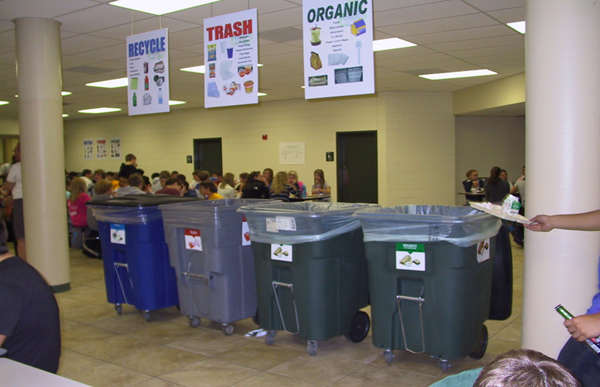School Enhanced Recycling and Source Separated Organics Case Study
ISD 197, Dakota County
Type of project:
Recycling and Food/Source Separated Organic
School description:
Garlough Environmental Magnet Elementary K-4, 401: staff: 58
Mendota Elementary K-4, 320: staff: 54
Moreland Elementary K-4, 328: staff: 74
Pilot Knob Elementary K-4, 293: staff: 56
Somerset Elementary K-4, 381: staff: 57
Friendly Hills Middle School 5-8, 615: staff: 76
Heritage Middle School 5-8, 688: staff: 94
Henry Sibley High School grades 9-12, 1363: staff: 136
For this project, all together there were 4,390 students and 605 staff.
Communities served: West St. Paul, Mendota Heights, and Eagan
Project purpose/goals:
The goal of this project was to improve the existing recycling program at all schools, improve the source separated organic (SSO) program at three schools, and start-up SSO at the five remaining schools. Before the project, the recycling program consisted of paper collection including corrugated cardboard and mixed containers (plastic bottles and aluminum cans) in all of the District�s schools and SSO recovery in three of the eight schools. There was no standardization of containers or signage/labels.
Materials targeted:
Paper, cardboard, bottles and cans, SSO.
Accomplishments:
The five elementary schools and two middle schools combined reduced the amount of waste going into the garbage by approximately 47%. This was accomplished by a combination of increased recycling and beginning SSO programs.
Project team:
District Sustainability Manager, school principals, custodians, green team leaders, and teachers.
Partnerships:
Rebecca Kulas with Dakota County, Tim Goodman with Tim Goodman and Associates, and Waste Management.
Process:
School walkthroughs were performed to get a sense of what the District�s existing recycling program was like. Their recycling program consisted of the collection of paper including corrugated cardboard and mixed containers (plastic bottles and aluminum cans) in all of the District�s SSO recovery in three of the eight schools. Based on the school walkthroughs and meetings, a plan was developed, which included:
- Determining the best placement of recycling and trash containers throughout the schools;
- Standardizing and color-coding all recyclable (blue), organics (green), and trash (black, gray, or brown) containers throughout the District;
- Labeling all containers with standardized County signage indicating what they are for;
- Provide new larger, blue recycling containers (23-gal. or 36-gal. square containers and/or 96-gal. Toter carts) for hallways and common areas;
- Ensuring that for every trash container there was a recycling container paired with it;
- Placing bottle-shaped recycling bins near vending machines and outside near trash bins;
- Expanding SSO collection to the remaining five schools;
- Engaging students in helping with development of an educational outreach effort to increase the awareness of the new program;
- Eliminating the separate cardboard dumpster at all schools except the high school, and placing cardboard in a mixed recycling dumpster.
The metrics for measuring the outcomes of the enhanced program included comparing monthly solid waste service costs for last year with solid waste service costs for this year. Additionally, the fullness of the back-end dumpsters was tracked for the first three months of the program to obtain estimated amounts of recyclables and organics recovered and trash disposed.
Prior to the start of school, open houses for parents and students were held at all the schools. Representatives from the District and the County were there to introduce the new program and answer any questions. Within a week of the start of school the program was in place.
During the first three months of the school year, a number of activities were undertaken to promote the new program and provide educational outreach to students, parents and the larger community. Among some of the activities undertaken were:
- Creating a recycling/composting page on the District website;
- Visiting each classroom (District Energy Manager and school principals) to talk with students and teachers about the program;
- Creating a video on composing and recycling in the lunch room;
- Holding a poster contest;
- Getting articles published in the St. Paul Pioneer Press and some of the school newsletters; and
- Implementing a Prize Patrol program for randomly rewarding teachers whose classroom recycling containers contain only recyclables and the trash containers containing only trash.
Classroom connections:
- Elementary Schools: principals and LIVEGREEN leaders went into each classroom to instruct students on proper disposal
- Middle school and high school: an information table was set up at the �back to school� events
- High school: link leaders (student leaders) were trained to help 9th graders in the cafeteria with sorting waste.
Project timeline:
The project was started in summer of 2009 for a beginning of school year 2009-2010 kick-off.
Cost/budget:
As part of the project, Dakota County had allocated $40,000 in funds for purchasing new infrastructure, providing signage/labels for those containers, and providing educational material.
Approximately $1,600 was saved by lowering solid waste disposal costs as a result of diverting recyclables. In the end, no cost savings were observed and the total cost of waste removal was the same. Recycling costs less than trash disposal, composting cost more than trash disposal, so in the end it was a push for which we were grateful.
Measurable Results:
During the first three months of the program, the elementary and middle schools recovered approximately 66,164 pounds of mixed recyclables and 591,000 pounds of SSO. It is estimated that this is a 47% increase over the previous year.
Lessons Learned:
- Starting with one school at a time, every facility has a unique set of challenges so start small to keep from getting discouraged.
- Use a variety of communication tools, let everyone know what you are doing, email staff, parents, make announcements, have assemblies, classroom instruction, poster, labels, etc. It has been said that it takes an average of 10 times for an ad to make an impact on a consumer; I think it's the same with making this kind of change in a school.
For further information, contact Rebecca Kulas, Environmental Specialist at the Dakota County Environmental Management Department.

�

